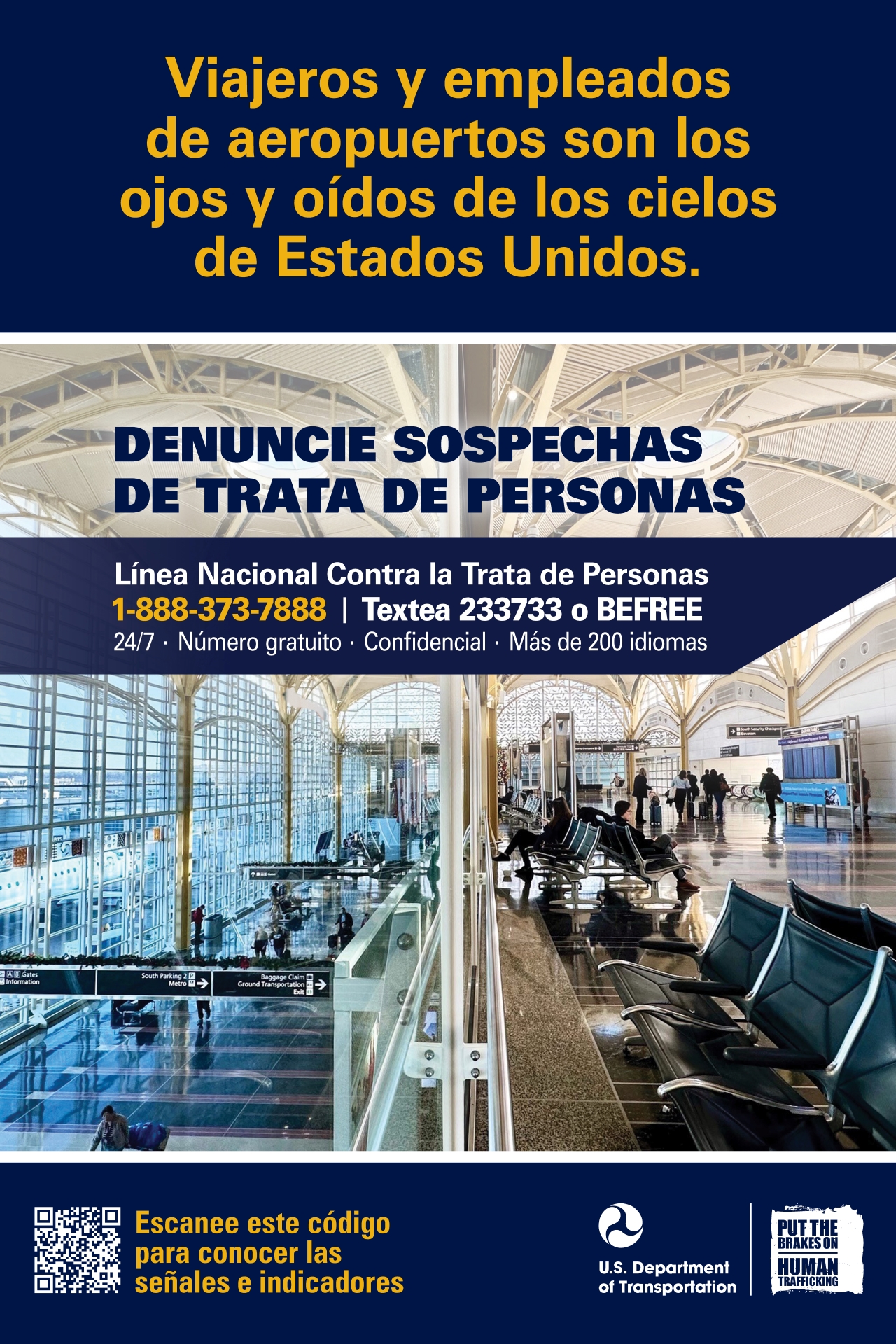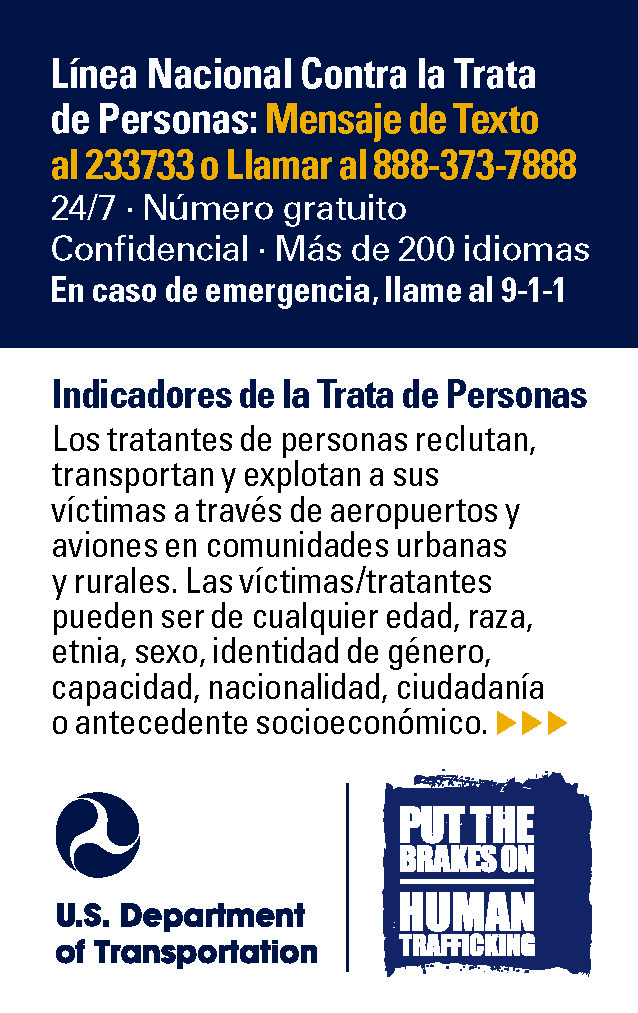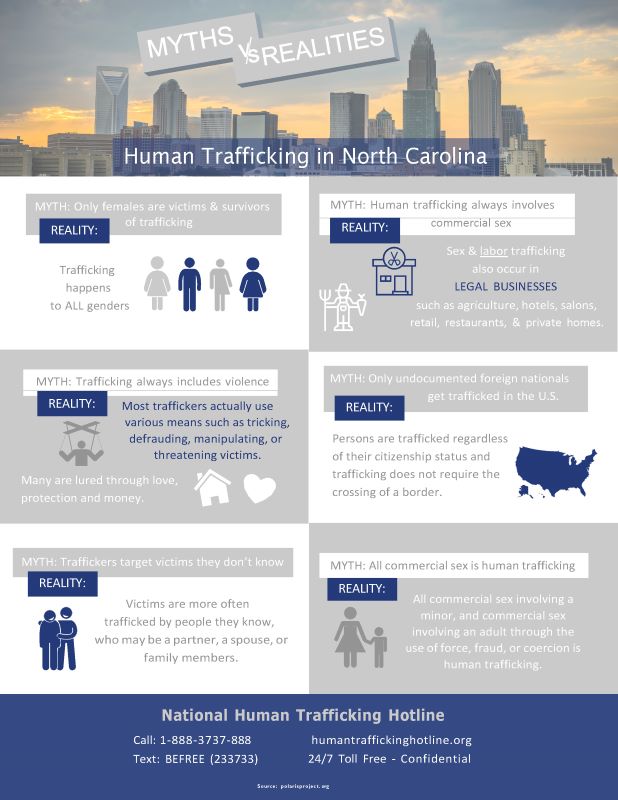Human Trafficking Awareness Resource Library
Awareness Signs
HELP US TO RAISE AWARENESS!
The following posters are available for you to download, print, display, and share. Posters should be displayed in a place that is clearly conspicuous and easily visible to employees and the public. Mandated Awareness Sign Locations
Instructions to obtain a copy of these awareness signs:
- Download a PDF copy to print. To view and print a compliant version of the poster, please click on the links below in the language and size needed. All of the online posters are displayed in Adobe Acrobat PDF format which should be viewable with your web browser.
- Click the preferred size and then download and save the file. Then, open the file in your PDF reader program. For best results, do not print the file directly from the web browser.
- For commercial printing, please use the "professional printer" link that is print ready with crop marks.
- Before printing the file, check to ensure that your printer can produce the specific poster size. If not, then set the printer settings to “Shrink to Fit” and select the proper paper tray. NOTE: These instructions are general because the configurations for each printer varies.
- Print the poster and display it to raise awareness.
- Click the preferred size and then download and save the file. Then, open the file in your PDF reader program. For best results, do not print the file directly from the web browser.
- Download an image to share on social media. Click on the thumbnail to view a larger image. Simply right-click on the poster thumbnail and save the image. Then, share it on Facebook, Instagram, Twitter, etc., to raise awareness to STOP HUMAN TRAFFICKING!
For more information about posting the awareness signs or requesting a specific translation needed for display, please email the North Carolina Human Trafficking Commission. Together, we can bring awareness to this crime and STOP HUMAN TRAFFICKING!
Best Practices and Toolkits
Human Trafficking Commission Standards of Service (2023)
Human Trafficking Mandated Reporting and Agency Response
Creating and Sustaining a Regional Response Team
Best Practices for Developing Material and Working with the Media
For programs using these signs for public awareness and outreach, please consider reading the following. The Senior Policy Operating Group (SPOG) Guide for Public Awareness Materials is now publicly available. This guide serves as a public resource that reflects the common messaging, standard statistics, and shared guidelines on images that SPOG agencies use when creating public awareness and external training materials. Media coverage and representation of an issue can influence the ways in which the public, policymakers and other interested parties come to understand and act upon the issue. At the minimum, responsible communication about trafficking should adhere to these guidelines: recognize the complexity of the issue by relying on multiple sources with a range of experiences; respect and amplify the voices of survivors; avoid victim blaming; and scrutinize competing statistical claims about trafficking prevalence and other phenomena.
Child Sex Trafficking Partner Toolkit by Polaris
CLAS Standards: The National Standards for Culturally and Linguistically Appropriate Services in Health and Health Care (The National CLAS Standards) aim to improve health care quality and advance health equity by establishing a framework for organizations to serve the nation's increasingly diverse communities.
Commercial Sexual Exploitation-Identification Tool (CSE-IT): The CSE-IT is an identification tool that does not involve structured questioning of clients. Instead, it outlines 48 factors for collecting information and assessing while speaking with the client and accessing other sources of information. To be used by a wide-range of professionals who work with the youth.
HEAL Trafficking Protocol Toolkit
HHS ACF Office of Trafficking in Persons Grant Management Toolkit
Human Trafficking and Assessment Measure (HTIAM-14): The HTIAM-14 is designed for use with youth who are experiencing homelessness. This tool has 14 categories of questions (some with sub-questions) and has been validated in a population of 18-23 year olds.
Human Trafficking Institute (HTI) Human Trafficking Restitution Resource Guide
Human Trafficking Screening Tool – Short Form (HTST-SF): Organizations can review and incorporate one or more of the questions in the Human Trafficking Screening Tool – Short Form (HTST-SF) into existing screening tools. These questions are: 1. Did someone you work for ever refuse to pay what they promised and keep all or most of the money you made? 2. Did you ever trade sexual acts for food, clothing, money, shelter, favors, or other necessities for survival before you reached the age of 18? 3. Were you ever physically beaten, slapped, kicked, punched, burned, or harmed in any way by someone you worked for? 4. Have you ever been unable to leave a place you worked or talk to people you wanted to talk to, even when you weren’t working, because the person you worked for threatened or controlled you? 5. Did someone you work for ever ask, pressure, or force you to do something sexually that you did not feel comfortable doing? 6. Were you ever forced to engage in sexual acts with family, friends, clients, or business associates for money or favors, by someone you worked for?
International Association of Chiefs of Police Toolkit
Labor Trafficking in Construction:
- Labor Trafficking and Other Labor Abuse in Houston’s Construction Industry – Fact Sheet
- Measuring Human Trafficking Prevalence in Construction: A Field Test of Multiple Estimation Methods, Final Report
- Risk and Protective Factors for Experiencing Labor Trafficking and Other Labor Abuse in the Construction Industry
National Advisory Committee Report on Best Practices Recommendations: Includes introduction videos and the PDF report.
National Child Traumatic Stress Network: Child Welfare Trauma Training Toolkit
Native Communities Resources:
- Native Youth Toolkit
- Culturally Responsive Approaches to Anti-Human Trafficking Programming in Native Communities
- Conducting Culturally Responsive Evaluation Engagement with Tribal and Native Communities
- Demonstration Grants to Strengthen the Response to Victims of Human Trafficking in Native Communities (VHT-NC) Program: Final Report of the Formative Evaluation
Office for Victims of Crime Model Standards
OTIP Office of the Administration for Children and Families
- Human Trafficking and Child Welfare: A Guide for Caseworkers
- La trata de personas y el bienestar de menores: una guía para trabajadores de casos
- Human Trafficking and Child Welfare: A Guide for Child Welfare Agencies
- SOAR for Human Trafficking Screening for Child Welfare Professionals
- SOAR for Safety Planning and Multidisciplinary Response for Child Welfare Professionals
- Human Trafficking: Working With Faith-Based Groups
- ACF OTIP Human Trafficking Prevention Month Toolkit January 2025
Quick Reference Guide for Disaster Management Professionals
Quick Youth Indicators for Trafficking (QYIT): The QYIT allows social service providers to quickly detect and serve young adults experiencing homelessness who have been victims of labor and/or sex trafficking.
Short Screen for Child Sex Trafficking (SSCST): The SSCST is a rapid screen designed for healthcare settings that consists of 6 questions regarding risk factors for commercial sexual exploitation. Youth screening positive are identified as at-risk and the clinician then follows up on the positive responses with open-ended questions to assess the level of concern for exploitation. The tool has been evaluated with adolescents ages 11-17 years, primarily those born or residing in the U.S., in emergency departments, teen clinics, and child advocacy centers.
The Irina Project (TIP) at the UNC-Chapel Hill Hussman School of Journalism and Media monitors and analyzes media representations of sex trafficking and provides resources, including tipsheets and training, for accurate and responsible coverage of the issue. Connect with The Irina Project on social media or contact [email protected].
Toolkit for Building Survivor Informed Organizations
Toolkit for Responding to Human Trafficking Through the Child Welfare System
Trafficking Victim Identification Tool (TVIT): The TVIT has two versions (validated for adults) the ‘short’ screen with 16 questions and the full version with 39. The English and Spanish versions of the tool can be used by victim service providers and law enforcement when faced with someone who may be a victim of sex and/or labor trafficking.
U.S. ACF Region IV Guiding Principles
U.S. Department of Health and Human Services 2025 Human Trafficking Prevention Month Toolkit
Vera Institutes Trafficking Victim Identification Tool: The TVIT has two versions (validated for adults) the ‘short’ screen with 16 questions and the full version with 39. The English and Spanish versions of the tool can be used by victim service providers and law enforcement when faced with someone who may be a victim of sex and/or labor trafficking.
- Spanish Version of the Vera Institutes Trafficking Victim Identification Tool: Este instrumento de identificación tiene como propósito usarse como parte del proceso regular de admisión o como parte de la inscripción en programas específicos. Para que los resultados sean válidos, la evaluación debe administrarse de acuerdo con protocolos predispuestos, ya sea que exista razón para creer que el cliente es una víctima de trata de personas o no. Por favor consulte las instrucciones paso a paso de la entrevista para ver las indicaciones sobre el uso de este instrumento de evaluación y manejo de los formularios de recolección de datos.
Fact Sheet
North Carolina Human Trafficking Commission Fact Sheet
Learn facts about the North Carolina Human Trafficking Commission.
Handouts
Human Trafficking in N.C. Handout
Labor Trafficking Handout
Sex Trafficking Handout
Human Trafficking Spanish Handout
Human Trafficking Indicator Card
Regional Response Teams
Human Trafficking Tray Liner
Human Trafficking Wallet Card
Human Trafficking Barcode Label
Human Trafficking Charges
Resource Directory List
Human Trafficking Commission Resource List
View a directory of anti-human trafficking organizations and services across North Carolina.
Speak Up NC
SpeakUpNC.org
Learn more about human trafficking, how to get help or report an incident, and what North Carolina is doing to help to raise awareness.
SpeakUpNC Video 1
SpeakUpNC Video 2
Social Media Ads
Download an image to share on social media. All images below are sized 1200x628. Click on the thumbnail to view a larger image. Simply right-click on the poster thumbnail and save the image. Then, share it on Facebook, Instagram, Twitter, etc., to raise awareness to STOP HUMAN TRAFFICKING!
Videos and Podcasts
Human Trafficking General Awareness
Human Trafficking (Law Enforcement Focus)
Common Myths About Human Trafficking
Agriculture Information
Child Welfare Information
Illicit Massage Information
Illicit Massage Information (Mandarin)
Illicit Massage Information (Korean)
FBI and National Center for Missing & Exploited Children Sextortion PSA
Podcasts
- 2023 - All Things Judicial Spotlights Human Trafficking in the Charlotte-Metro Community
- January 2022
- North Carolina Justice Academy Podcasts for January 2021
Disaster Resources
Legal Aid of North Carolina: Tropical Storm Helene Disaster Assistance
- Recovery Resources, Assistance NOW, Long-Term Support, Applying for FEMA, Disaster Unemployment Assistance, LANC Resource Library, Donate, Pro Bono, and more!
- Attachments (English and Spanish versions): Disaster unemployment assistance flyer, Disaster Assistance Flyer, Recovery Resources, SEVEN THINGS FOR IMMIGRANTS TO KNOW IN TIME OF DISASTER.
ReadyNC.gov
Shield NC
N.C. Department of Health and Human Services Division of Social Services
Administration for Children and Families:
- Fact Sheet: Human Trafficking Programming During Disasters and Emergencies
- Includes: Preventing Human Trafficking during disasters and emergencies
- Remote service delivery during disasters and emergencies
- Remote technical assistance during disasters and emergencies
- Sustaining organizations during disasters and emergencies
- Fact Sheet: What Disaster Responders Need to Know and Do
- Labor Trafficking in Construction During the Recovery and Reconstruction from a Natural Disaster
- Pocket Cards: Human Trafficking Resources for Individuals Affected by an Emergency or Disaster
- SOAR Online: Disaster Management - Preventing and Responding to Human Trafficking
- Webpage: Disaster and Emergencies
NCMEC Resources
- National Emergency Child Locator Center
- The Unaccompanied Minors Registry (UMR)
- Team Adam
- Family emergency playbook SPANISH and ENGLISH
- Rapid Response Cards SPANISH and ENGLISH






































